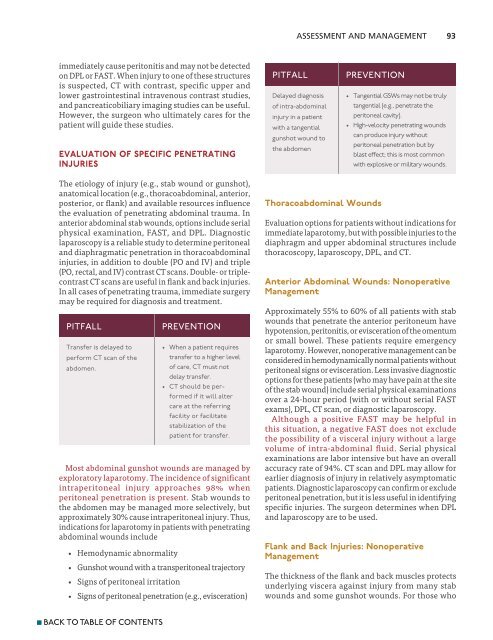Advanced Trauma Life Support ATLS Student Course Manual 2018
You also want an ePaper? Increase the reach of your titles
YUMPU automatically turns print PDFs into web optimized ePapers that Google loves.
ASSESSMENT AND MANAGEMENT 93<br />
immediately cause peritonitis and may not be detected<br />
on DPL or FAST. When injury to one of these structures<br />
is suspected, CT with contrast, specific upper and<br />
lower gastrointestinal intravenous contrast studies,<br />
and pancreaticobiliary imaging studies can be useful.<br />
However, the surgeon who ultimately cares for the<br />
patient will guide these studies.<br />
EVALUATION OF Specific Penetrating<br />
Injuries<br />
Pitfall<br />
Delayed diagnosis<br />
of intra-abdominal<br />
injury in a patient<br />
with a tangential<br />
gunshot wound to<br />
the abdomen<br />
prevention<br />
• Tangential GSWs may not be truly<br />
tangential (e.g., penetrate the<br />
peritoneal cavity).<br />
• High-velocity penetrating wounds<br />
can produce injury without<br />
peritoneal penetration but by<br />
blast effect; this is most common<br />
with explosive or military wounds.<br />
The etiology of injury (e.g., stab wound or gunshot),<br />
anatomical location (e.g., thoracoabdominal, anterior,<br />
posterior, or flank) and available resources influence<br />
the evaluation of penetrating abdominal trauma. In<br />
anterior abdominal stab wounds, options include serial<br />
physical examination, FAST, and DPL. Diagnostic<br />
laparoscopy is a reliable study to determine peritoneal<br />
and diaphragmatic penetration in thoracoabdominal<br />
injuries, in addition to double (PO and IV) and triple<br />
(PO, rectal, and IV) contrast CT scans. Double- or triplecontrast<br />
CT scans are useful in flank and back injuries.<br />
In all cases of penetrating trauma, immediate surgery<br />
may be required for diagnosis and treatment.<br />
Pitfall<br />
Transfer is delayed to<br />
perform CT scan of the<br />
abdomen.<br />
Most abdominal gunshot wounds are managed by<br />
exploratory laparotomy. The incidence of significant<br />
intraperitoneal injury approaches 98% when<br />
peritoneal penetration is present. Stab wounds to<br />
the abdomen may be managed more selectively, but<br />
approximately 30% cause intraperitoneal injury. Thus,<br />
indications for laparotomy in patients with penetrating<br />
abdominal wounds include<br />
••<br />
Hemodynamic abnormality<br />
••<br />
Gunshot wound with a transperitoneal trajectory<br />
••<br />
Signs of peritoneal irritation<br />
prevention<br />
• When a patient requires<br />
transfer to a higher level<br />
of care, CT must not<br />
delay transfer.<br />
• CT should be performed<br />
if it will alter<br />
care at the referring<br />
facility or facilitate<br />
stabilization of the<br />
patient for transfer.<br />
••<br />
Signs of peritoneal penetration (e.g., evisceration)<br />
Thoracoabdominal Wounds<br />
Evaluation options for patients without indications for<br />
immediate laparotomy, but with possible injuries to the<br />
diaphragm and upper abdominal structures include<br />
thoracoscopy, laparoscopy, DPL, and CT.<br />
Anterior Abdominal Wounds: Nonoperative<br />
Management<br />
Approximately 55% to 60% of all patients with stab<br />
wounds that penetrate the anterior peritoneum have<br />
hypotension, peritonitis, or evisceration of the omentum<br />
or small bowel. These patients require emergency<br />
laparotomy. However, nonoperative management can be<br />
considered in hemodynamically normal patients without<br />
peritoneal signs or evisceration. Less invasive diagnostic<br />
options for these patients (who may have pain at the site<br />
of the stab wound) include serial physical examinations<br />
over a 24-hour period (with or without serial FAST<br />
exams), DPL, CT scan, or diagnostic laparoscopy.<br />
Although a positive FAST may be helpful in<br />
this situation, a negative FAST does not exclude<br />
the possibility of a visceral injury without a large<br />
volume of intra-abdominal fluid. Serial physical<br />
examinations are labor intensive but have an overall<br />
accuracy rate of 94%. CT scan and DPL may allow for<br />
earlier diagnosis of injury in relatively asymptomatic<br />
patients. Diagnostic laparoscopy can confirm or exclude<br />
peritoneal penetration, but it is less useful in identifying<br />
specific injuries. The surgeon determines when DPL<br />
and laparoscopy are to be used.<br />
Flank and Back Injuries: Nonoperative<br />
Management<br />
The thickness of the flank and back muscles protects<br />
underlying viscera against injury from many stab<br />
wounds and some gunshot wounds. For those who<br />
n BACK TO TABLE OF CONTENTS

















